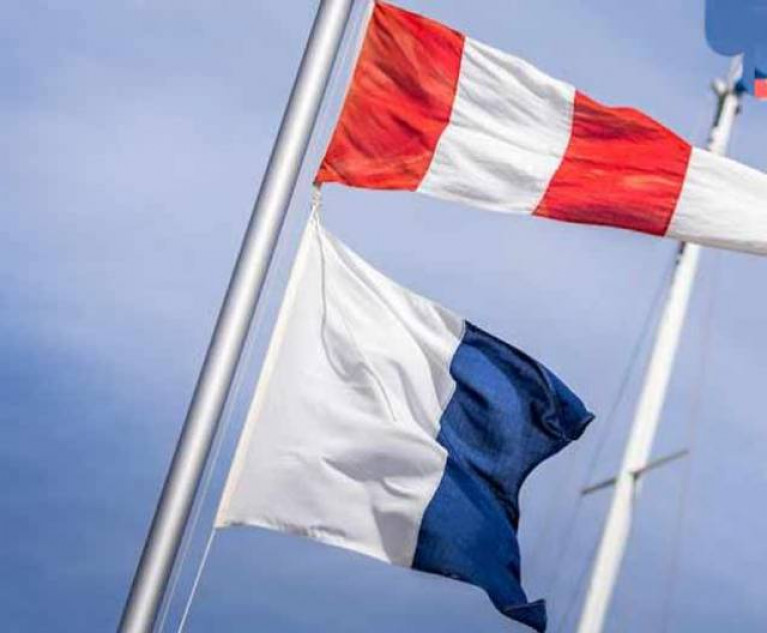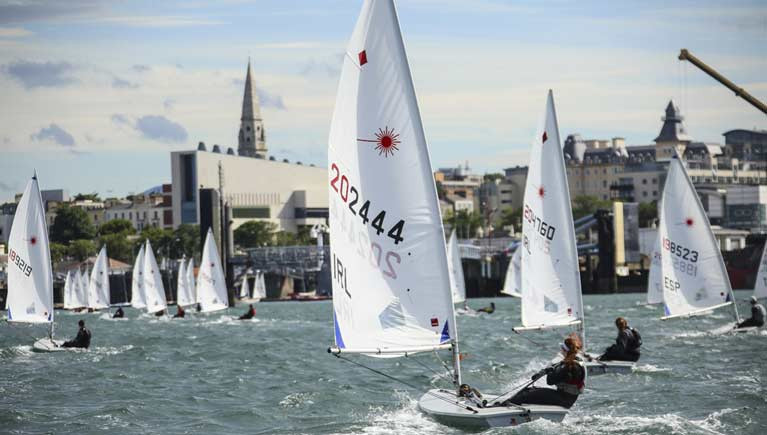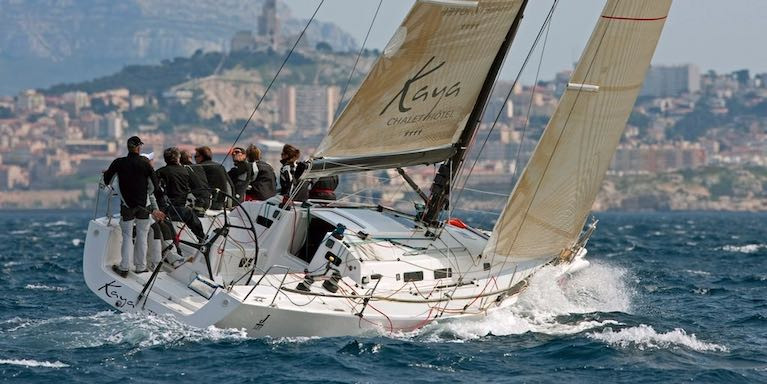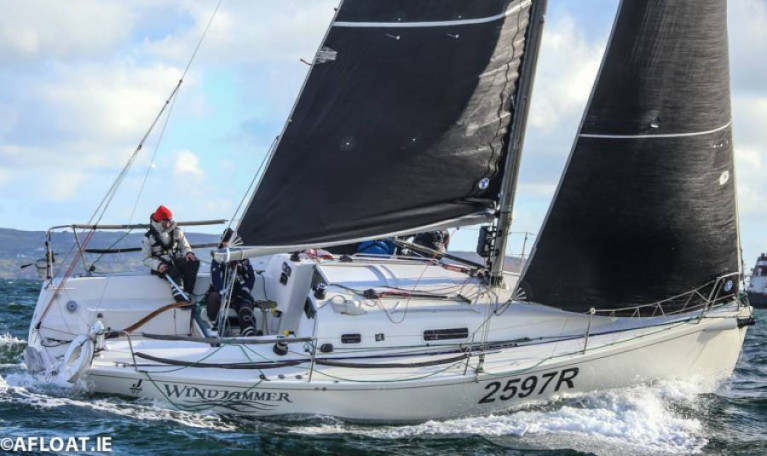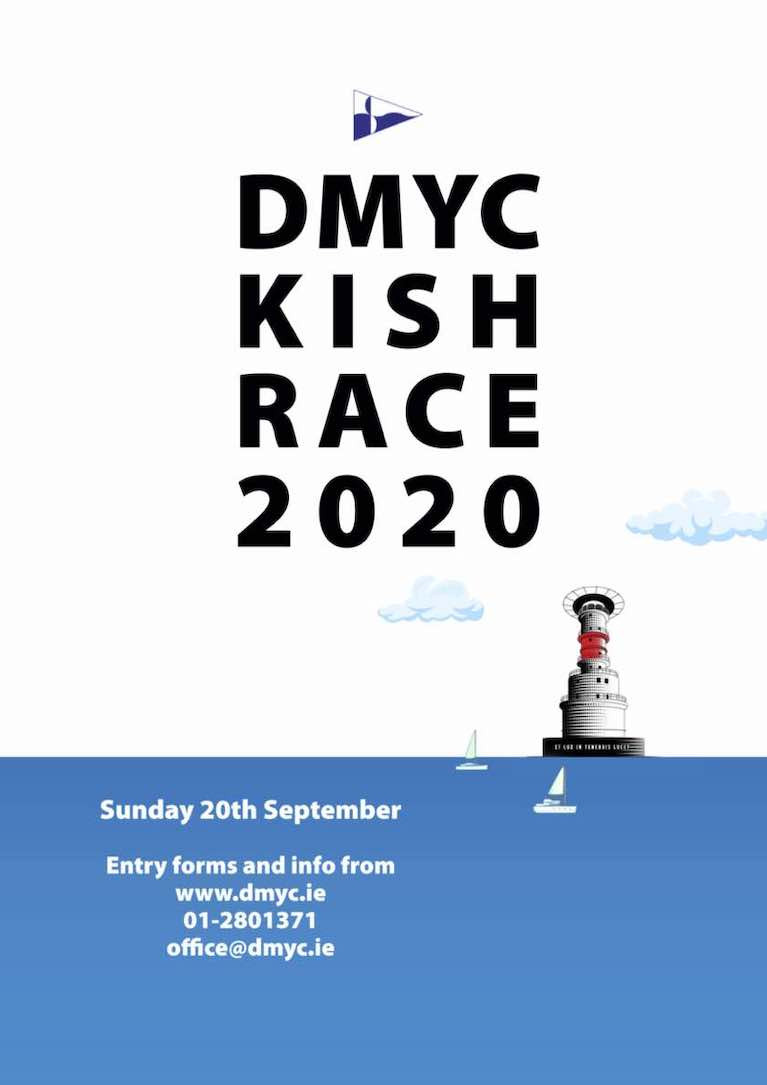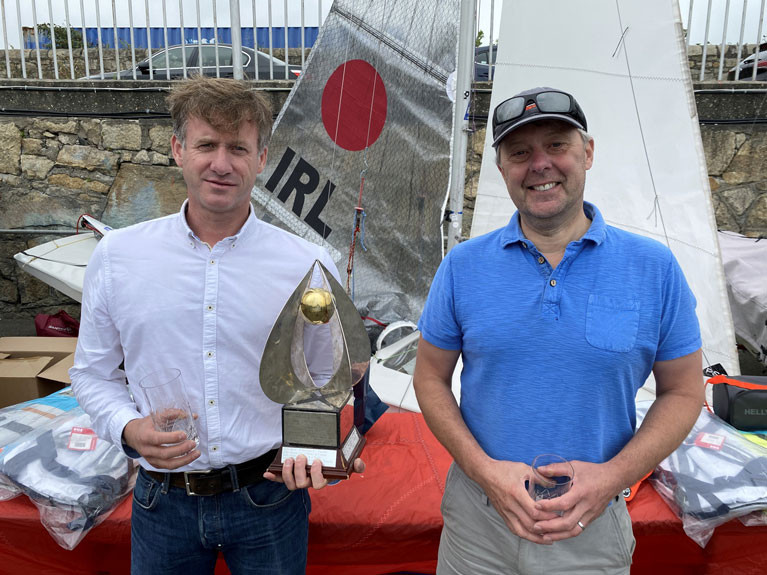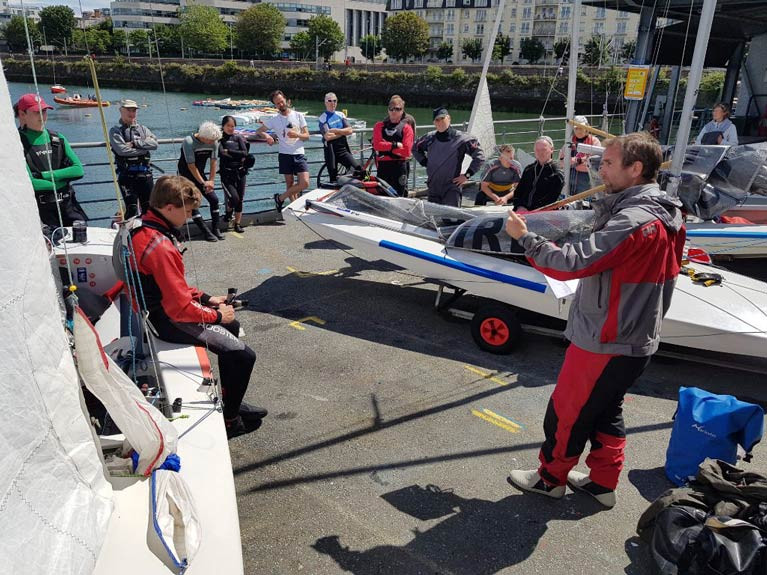Displaying items by tag: dmyc
Barry McCartin and Conor Kinsella are the new Fireball National Championships after eight races in Dublin Bay over the weekend. Second-placed at the event, hosted by the DMYC, were Noel Butler and Stephen Oram while the Thompson brothers Daniel and Harry took third. The event was compressed into two days of racing when Friday was lost to zero breeze.
Saturday proved the best day in terms of wind with a solid North-Easterly providing decent pressure and full trapezing conditions. Principal race officer Suzanne McGarry and her team did a brilliant job in getting four solid races under the belt by mid-afternoon when the sea breeze showed signs of weakening. Two windward-leeward courses were followed by two Olympic Triangular courses with exemplary turnarounds.
McCartin/Kinsella dominated the 13 boat fleet on Saturday though they didn't have things entirely their own way with the Thompsons posting a win in race two. The pair showed great coordination and teamwork around the race track. While they squeezed the optimum VMG out of the boat upwind they were exceptionally fast offwind, especially on the triangular courses.
On the Sunday morning a different set of conditions greeted sailors who initially roasted ashore in high temperatures but zero breeze. After a postponement of an hour, however, the sea-breeze started to fill and racing got underway in lightish but very sailable conditions. Again race officer Suzanne McGarry started with windward-leeward courses and followed up with two Olympic Triangles. McCartin/Kinsella again led the fleet for the first two bullets but the third race was led by Butler/Oram while the series leaders headed ashore to fulfil a work commitment.
 Noel Butler (right) and Stephen Oram were second
Noel Butler (right) and Stephen Oram were second
 Daniel and Harry Thompson who were third overall
Daniel and Harry Thompson who were third overall
Race 8 took place without the event leaders and Butler/Oram posted another win. However, McCartin/Kinsella had done enough with five races wins and a second to discard the last two races and still win the overall by a margin of 5 points. Further back in the fleet there was great close racing all the way through. Lizzy McDowell sailing with her cousin Chara in a borrowed boat were right on the pace and came in into their own on day two. They were unfortunate to be U-flagged in the final race but they were in good company as the Thompsons and Louise McKenna/ McKenna/Hermine O'Keeffe suffered the same fate. Frank Miller/Ed Butler had a better first day than second but managed to hold onto 4th overall.
The McDowell cousins placed 5th and took the silver prize while second silver was Colm Breen with his son Cormac and third were Dave Coleman sailing with Aidan Caulfield.
 Colm Breen and son Cormac (2nd silver)
Colm Breen and son Cormac (2nd silver)
 Aidan Caulfield (3rd silver) (left) with DMYC Commodore Dermot Reidy
Aidan Caulfield (3rd silver) (left) with DMYC Commodore Dermot Reidy
There were notable new faces at the event with youngsters Daniel Hrymac crew Harvey, young Robin Nash sailing with her father Glen and veteran Ciaran Hickey returning to the fray. All in all a great event in semi-tropical conditions and all credit to the race team who managed to squeeze 8 races in to complete the series.
Next up for the Fireballers is the Ulsters in Newtownards on August 21/22 and on September 18/19 the fleet head to Dromineer to sample the conditions at Lough Derg YC, the venue of the Fireball World Championships next year.
John Masterson's Curraglas of the National Yacht Club is 2021 Shipman Irish National Championship winner after a four-race series at Dun Laoghaire Harbour this weekend.
RStGYC's Viking (Fergus Mason and Colm Duggan) was second overall. Third was clubmate Alain Deladiennee's in Poppy.
Masterson won by a one-point margin in the eight boat fleet after four races sailed at the DMYC hosted championships.
Results are here
DMYC Dinghy Christmas Cracker Event is Abandoned as Covid Numbers Increase
A DMYC Committee meeting held this weekend has decided to abandon plans for its inaugural Christmas Dinghy Challenge at Dun Laoghaire Harbour.
As Afloat previously reported, the event was scheduled in anticipation of the lifting of Level 3 restrictions this weekend but the club's Neil Colin told Afloat, "A change in direction of the tide (Pandemic Numbers, coupled with the NPHET commentary, and anticipated relaxation that has not occurred) have led us to abandon the Christmas Challenge"
The DMYC is celebrating 50 years of winter sailing organisation this year.
The club has removed its online registration system and any entry fees will be refunded, according to Colin.
"These are sad times but we look forward to fair winds in 2021, and want to ensure everyone remains as safe as possible", he added
DMYC Launch 'Christmas Cracker' Dun Laoghaire Harbour Dinghy Event
The Dun Laoghaire Motor Yacht Club (DMYC) has its “Christmas Cracker” dinghy series, in anticipation of the amended Level 3 Restrictions due to take effect on 18th December, to give all East Coast dinghy sailors a chance to “pull in their sheets and wear rubber” over the festive season, in anticipation that many sailors will be staying local.
The DMYC is celebrating 50 years of winter sailing organisation this year.
The event will take place on Sundays 20th, 27th and New Year’s Day 1st January, commencing @ 12.00 in the main harbour.
The event is intended for double-handed and solo sailors, with a PY handicap of 1400 or lower.
A Notice of Event and registration system is now live here. Download an event poster below.
The event will be capped at the first 100 entrants. The DMYC's Neil Colin says, "If we cannot go sailing due to the pandemic, the nominal entrance charge will be refunded".
This is an open event, visitors on the days are welcome to use the harbour’s public slipways as well as the regular waterfront slipways, to minimise congregation and maintain safe distancing.
There will be no social “after sail” gatherings, and club changing rooms are expected to be closed. Consequently, a “sail and dash” approach is needed, and even this season’s fashion accessory, the 'Dry Robe' will come in handy.
DMYC Kish Race on Dublin Bay is Postponed Due to COVID
The DMYC Kish Race on Dublin Bay that has attracted 51 entries for this Sunday morning's start off Dun Laoghaire Harbour has been postponed due to the Level 3 COVID restrictions coming into effect at midnight.
The annual fixture has assembled a sizeable fleet including yachts from nearby Greystones Harbour in County Wicklow.
DMYC race organisers hope to reschedule the race and plan to advise competitors early next week.
Greystones Harbour Boats to Boost DMYC Kish Race Entry on Sunday
Up to six County Wicklow boats will travel from Greystones Harbour early on Sunday morning to compete in the DMYC Kish Race swelling the already buoyant 40-boat entry for the annual Dublin Bay Race.
The Greystones visitors include the latest entry Frank Whelan's new J122 Grand Prix, Kaya, that will make its Irish race debut at the Dun Laoghaire Harbour event.
Whelan's new yacht is a sister ship to the well-known Royal St. George J122 Aurelia, a top Irish offshore performer.
Kaya is a replacement for Whelan's all beating Eleuthera, a Grand Soleil 44, that has been sold to new owners in Cascais, Portugal.
Kaya arrived in Ireland just a fortnight ago from France, so she is still in shakedown mode, according to her skipper for the Kish Lighthouse Race, Paddy Barnwell.
A new entry is Paul Barrington's well-known J109 "Jalapeno" from the National Yacht Club that will also be a serious contender for line and class honours in this year's race.
As Afloat previously reported, the race takes place from the DBSC Hut area at the back of the West Pier, starting at 10.30 am on Sunday.
The race has already attracted an entry of over 40 boats and promises to offer some impressive "head to heads" amongst the various competitors. The recent access of George Miller in "The Den" is no doubt welcomed by his Shipman classmates.
In the Ruffian 23s, David Meek and NYC Commodore Martin McCarthy are also racing out to the lighthouse.
Race Officer (RO) Larry Power is hoping for fair winds for the race. Currently forecast is for 10 to 16 knots from the East with the possibility of some sunshine.
The RO has the option to set an Inflatable Mark that will not be quite as far as the Kish if the feeling is that the wind is not sufficient.
Due to demand, The DMYC have extended the Entry Cut Off to 1900hrs on Saturday 19th. You can enter here.
Sailing Instructions are downloadable below.
The current entry is below:
CURRENT KISH RACE ENTRY LIST 2020


Dublin Bay DMYC Kish Race Hots Up With 35 Entries & Counting for Sunday's Start
With entries close to 35 boats, the annual DMYC Kish Race has been made all the more interesting with some of top ISORA boats now entered for this Sunday's Race on Dublin Bay.
ISORA coastal regulars such as the Royal Irish's new Prima Forte, a Beneteau First 40, plus the Royal St. George's J97 Windjammer, the National Yacht Club's Sunfast 3600 and the Dun Laoghaire Marina based First 310, More Mischief are all now entered.
The organisers have acceded to a request from Cruiser 3 Class Captain, Kevin Byrne, that the results from the race be used for part of the Cruiser 3 Annual Championships which also takes place this week.
 The Grzegorz Kalinecki skippered First 310, More Mischief
The Grzegorz Kalinecki skippered First 310, More Mischief
The Cruiser 3 Class will use a combination of their Saturday DBSC results and the Kish Race results to decide the 2020 Champion.
The Committee is also very grateful to Larry Power (NYC) who kindly agreed to be PRO assisted by regular Club Stalwarts, Brian Mulkeen and Rodney Beste. The Race begins at 1030 hrs from the normal DBSC "HUT" starting area, and the Finish will be between the East and West Pier Lighthouses (for any spectators with an Interest!).
In a change from last year's format, the Committee has elected to have three separate starts, One for Cruisers 0/1; another for Cruisers 2/3 and Shipmans and finally a start for Cruisers 5 and Ruffians.
The club has also elected to award Prizes not only to the Overall Winner ( the magnificent "Kish Trophy") but also to the winners of each Cruiser Class, Shipmans and Ruffians.
 John O'Gorman's Sunfast 3600 'Hot Cookie' from the National Yacht Club
John O'Gorman's Sunfast 3600 'Hot Cookie' from the National Yacht Club
John O'Gorman's "Hot Cookie" will no doubt cut a dash in Cruiser 0/1 along with former DMYC Commodore Leslie Parnell in "Black Velvet" along with "Prima Luce".
No doubt the Ruffians and Shipmans will have battle "Royale" given the List of keen Helms including Gerry Glynn, Brendan Duffy, Michael Cutliffe and many others.
The regular inhabitants of the 55-year-old Kish Lighthouse (Cormorants and Herring Gulls in the main) are in for some disturbance this Sunday!
The DMYC have confirmed that they are extending the Entry Deadline up to 7 pm on Saturday 19th of September. You can enter here
The Kish Race 2020 entrants so far are as follows:


DMYC Prepares for Annual Kish Race on September 20
Dun Laoghaire Motor Yacht Club (DMYC) has published details of the 2020 edition of its annual Kish Race on Dublin Bay later this month.
The round Kish and back race will take place on Sunday 20th with the first gun at 10.25 a.m.
Starting in the vicinity of Dun Laoghaire Harbour and racing to the Kish lighthouse and back, it is a distance of approximately 28 km.
There will be three starts separated by five-minute Intervals.
- 1st Start Cruiser 0 and 1
- 2nd Start Cruiser 2
- 3rd Start Cruiser 3, 4,5. Shipman and Ruffians
Race organiser Ben Mulligan says that 'as this is the “last major” in the Dublin Bay summer season before the lift out or winter racing, the club is looking forward to an enthusiastic entry'.
Handicapping will be based on ECHO Standard, giving those with revised ECHOs a good chance at the prizes.
Results for the race will be calculated using ECHO standard TCF handicaps, or equivalent. Overall prizes will be awarded for the best performance. (The Kish Race Trophy)
In addition, there will be a Prize awarded for the first Shipman and the first Ruffian and the first in each cruiser class.
Unfortunately, this year organisers cannot offer the hospitality of the DMYC for the prizegiving but prizes will be sent to the winners.
The entry fee is €25
At a time when the Irish Fireball fleet should have been in Howth, welcoming Fireballers from all over the World to the 2020 Fireball World Championships, a 13-boat fleet was contesting what we think is the first National Championship to be hosted in a Covid-ravaged summer calendar. When the Worlds and Nationals in Howth were cancelled due to COVID, Dun Laoghaire Motor Yacht Club offered to host the event and principal regatta organiser, Neil Colin, secured sponsorship from Helly-Hansen.
The headline for this report could have come from any number of sources, “Fireball women to the fore” with reference to the three race wins achieved by our all-lady crews, “Tight racing for Fireball Nationals” despite the points tally on the final score, “Challenging conditions for race management and competitors” reflecting the dearth of healthy wind, or “DMYC step up to the plate to host Fireball Nationals”.
 Second Overall Louise McKenna & Hermine O'Keeffe
Second Overall Louise McKenna & Hermine O'Keeffe
What is most important, however, is that I am able to bring to you a report on a regatta that a few short weeks ago might have been deemed impossible such is the impact of the health crisis. Instead, due to the specific efforts of DMYC and the Irish Fireball Class Association in our case and Irish Sailing who have engaged with the relevant bodies in this crisis to get people back out on the water across the country, there is a regatta report to be written.
 Third Overall - Daniel & Harry Thompson
Third Overall - Daniel & Harry Thompson
Six different clubs were represented in the fleet, with DMYC claiming the biggest representation at 5, the National Yacht Club, the Royal St George Yacht Club and Sailing in Dublin 2 each and Wexford Harbour Boat and Tennis Club and Lough Ree Yacht Club one each.
 Silver Fleet Winners, Clodagh Nash & Glen Fisher
Silver Fleet Winners, Clodagh Nash & Glen Fisher
That’s who were present and at a dinner on Saturday night we worked out that there could have been at least another five boats sailing which weren’t due to a series of personal circumstances.
 Classic Fireball Winners Colm Breen (left) & Cormac Power Breen with DMYC Commodore Frank Guilfoyle
Classic Fireball Winners Colm Breen (left) & Cormac Power Breen with DMYC Commodore Frank Guilfoyle
In addition to the Fireball stalwarts, we had Ben Graf and Alexander Farrell representing Lough Ree Yacht Club in Frank Miller’s “Blind Squirrel” 14713. These two young men have been campaigning a 420 and showed us that the step up to Fireballs isn’t that severe in the conditions that we “enjoyed” over the weekend. The two SID boats were Colm Breen & Cormac Power Breen and Nick Miller & Cearbhall Daly, respectively while Paul Ter Horst and Pavlo Tishkin made their Fireball regatta debut in the recently acquired 14790. And carrying on from last year, Clodagh Nash had Glen Fisher crewing in 14691.
 Irish Fireball Championships 2020 Prizegiving MC Neil Colin with Margaret Casey
Irish Fireball Championships 2020 Prizegiving MC Neil Colin with Margaret Casey
Proceedings got under late on Friday afternoon in pleasant conditions even if the wind was a little on the sparse side – a subsequent feature of the entire weekend. Defending champions Noel Butler & Stephen Oram (15061) stamped their mark on proceedings with a comfortable win in Race 1 but a tighter win in Race 2. An early indication that this wasn’t going to be a fun regatta for the “420 boys” was confirmed when they took two second places with the third places being shared by Neil Colin & Cormac Bradley (14775) and Alistair Court & Gordon Syme (14706). However, a bit like the first round of the USPGA the day before, there was a log jam of boats in third place after two races all counting 9 points – included in the cluster were Colin & Bradley, Court & Syme, Daniel & Harry Thompson (15156, 5&4), Louise McKenna & Hermine O’Keeffe (15016, 4&5). At the other end of the fleet, Nash, Ter Horst & Breen were covered by 2 pts.
Regatta organiser, Neil Colin arranged for socially-distanced refreshments to be available after racing where post-mortems were undertaken – but all in good spirit – no pun intended.
The fleet reconvened at 09:30 on Saturday in glorious sunshine but again the wind was conspicuous by its absence. With DBSC racing scheduled and the SB20s also racing in Dublin Bay, Race Officer Suzanne McGarry and her team took the fleet off towards the west to make sure that all of the fleets on the Bay had their “own turf”. Butler & Oram took another win in Race 3, followed home by Graf & Farrell – Was this going to be the pattern for the rest of the regatta? The Thompsons clearly decided that it wasn’t because they started their assault on the title with a third place, followed home by Frank Miller & Ed Butler (14990). McKenna & O’Keeffe counted a 5th place.
However, in Race 4, the applecart was overturned and shortly after the start the leading two boats appeared to be in very close company at the back end of the fleet – surely the “fun and games” wasn’t going to start this early! Butler later conceded that he had had a poor start and it was just coincidence that Graf was in the same vicinity. In persistently light and challenging conditions, the finishing order was; the Thompson brothers, McKenna & O’Keeffe, Court & Syme, with Graf & Farrell 4th, Miller & Butler 5th and Butler & Oram back in 6th, a most unusual result for them – it would become one of their two discards. An early halt to the racing saw the fleet ashore by 16:00 as the fickle wind was getting just too fickle!
With five races down the situation was unusually tight at the top of the leader-board, Butler & Oram (7.0) led by 1 from Graf & Farrell, with the Thompsons a further 3pts adrift but only one ahead of McKenna & O’Keeffe who had a six-point cushion on Court & Syme. Nash & Fisher led the Silver fleet by a one-point margin over Breen & Power-Breen who had a point less than Ter Horst & Tishkin.
Post-mortems followed in glorious sunshine (suitably distanced) and a significant number of the fleet then relocated to dinner in the National Yacht Club.
The forecast for Sunday didn’t promise any more wind and a lot less sunshine. And just as the horse-racing fraternity have a “Ladies Day” at the big meetings, so the Fireball fleet had their own version of a Ladies Day when first Louise & Hermine and then Cariosa Power & Marie Barry (14854) scored race wins. Louise and Hermine won their race in pressured circumstances as the racing at the front of the fleet was tight, but Power & Barry romped home with a “Butler-esque” lead – they got further away from the fleet the longer the race went on! It was a fantastic fillip for the four women and the regatta in general even if Butler, Thompson and Graf might not have shared their joy on the water (in regatta terms).
Butler & Oram scored a second place behind McKenna & O’Keeffe in Race 6 but they were unable to drop their spinnaker completely at the last leeward mark of the Windward-Leeward course. Further investigation, on the water, found that the spinnaker halyard had shredded within the mast, but some very clever manipulation of the main halyard allowed them to get back into racing format with an operational spinnaker halyard. It was a close call! The Thompsons took third in Race 6 and followed up with a 4th in Race 7. Graf & Farrell had a bigger problem in Race 6, scoring a DSQ for going through the start/finish line while the blue flag was flying. They then scored a 6th in the seventh race and these two scores were to be their discards. McKenna added a fifth place to her first place from Race 6 in Race 7 and impressively, considering the pre-race drama, Butler & Oram scored a third in Race 7. Court & Syme had a “purple patch” race in Race 7 to finish 2nd, their regatta high point.
In Race 8, Butler & Oram closed their account in the same way they had opened it – with a win. Behind them the finishing order was the Thompsons, McKenna & O’Keeffe, Owen Sinnott & Grattan Donnelly (14865) – a great result for them – and Graf & Alexander.
As I hope this report confirms, the winners didn’t have the regatta all their own way, even if they had a 7pt margin at the end. Noel Butler acknowledged as much at the prize-giving and the fact that we had four different race winners is a testimony to the competitiveness of the regatta. For the two all-women crews to take three race wins was very encouraging and livened up the competition for everyone. Racing in the Gold Fleet was tighter than the numbers will reflect and some well established Fireballers struggled to keep big numbers off their score cards – no names, no pack drills. The fact that the younger combinations of Daniel & Harry Thompson and Ben Graf & Alexander Farrell enjoyed individual race successes, if not race wins, then certainly podium places, was also good for the regatta.
In the Silver fleet, the final finishing order was Nash & Fisher, Breen & Power Breen, Ter Horst & Tishkin and Miller & Daly.
In addition to the perpetual prizes for 1,2,3 Overall, 1st Silver and 1st Classic, Helly-Hansen provided sponsor prizes which were the subject of a raffle open to the competitors and Race Management team alike. The prize-giving was conducted by DMYC Vice Commodore Neil Colin with assistance from Margaret Casey.
 Irish Fireball Championships 2020 Race Officer Suzanne McGarry with her present from the Irish Fireball Class Association
Irish Fireball Championships 2020 Race Officer Suzanne McGarry with her present from the Irish Fireball Class Association
Irish Fireball Championships 2020 Race Officer Suzanne McGarry with her present from the Irish Fireball Class Association
A special word goes to Suzanne McGarry and her race management team who worked very hard to provide eight of the nine scheduled races. While the sun-gods might have shone on them, particularly on Saturday, the wind gods were less generous. At the prize-giving, due thanks were recorded to Suzanne, her team and the organising team of DMYC. Club Commodore Frank Guilfoyle presented the prizes and closed out the proceedings by thanking the competitors, the race management team and his own DMYC team for their collective efforts in making the regatta happen. Frank Miller, representing the Irish Fireball Class, thanked the club and Suzanne McGarry was presented with a variation on the usual gift from the Class Association.
|
HELLY-HANSEN IRISH FIREBALL NATIONALS DUN LAOGHAIRE MOTOR YACHT CLUB; 7 – 9 AUGUST 2020 |
||||||||||||
|
Sail No. |
Crew |
Club |
R1 |
R2 |
R3 |
R4 |
R5 |
R6 |
R7 |
R8 |
Nett |
|
|
1 |
15061 |
Noel Butler & Stephen Oram |
NYC |
1 |
1 |
1 |
6 |
4 |
2 |
3 |
1 |
9 |
|
2 |
15016 |
Louise McKenna & Hermine O’Keeffe |
RStGYC |
4 |
5 |
5 |
2 |
1 |
1 |
5 |
3 |
16 |
|
3 |
15156 |
Daniel & Harry Thompson |
WHBTC |
5 |
4 |
3 |
1 |
3 |
3 |
4 |
2 |
16 |
|
4 |
14713 |
Ben Graf & Alexander Farrell |
LRYC |
2 |
2 |
2 |
4 |
2 |
14 |
6 |
5 |
17 |
|
5 |
14706 |
Alistair Court & Gordon Syme |
DMYC |
6 |
3 |
8 |
3 |
6 |
7 |
2 |
9 |
27 |
|
10 |
14691 |
Clodagh Nash & Glen Fisher |
RStGYC |
9 |
12 |
10 |
10 |
13 |
9 |
10 |
10 |
58 |
|
11 |
15058* |
Colm Breen & Cormac Power Breen |
SID |
11 |
10 |
13 |
11 |
10 |
11 |
11 |
11 |
64 |
Nine Fireballs took part in specialist coaching sessions at DMYC this weekend led by former Olympic sailor Phil Lawton. The event, supported by Irish Sailing, was geared towards optimizing crew work in a fast two-hander dinghy. Phil spent a solid year with Ger Owens practising and perfecting their techniques in the 470 for the Beijing Olympics so it was a real bonus for the Fireball class to pick his brains. Amongst the regular Fireballers were some younger teams relatively new to Fireballs including Harry Thompson with Jack McDowell as helm, Ben Graf and Alexander Farrell from Lough Ree, and young Clodagh Fischer sailing with her father Glen. The opening message to the sailors was simple - there are two crews in a two- handed boat, what each does is very different but they have the same goal. While the emphasis throughout the sessions was on the (front!) crew's role the importance of communications and mutual support was emphasised throughout. This philosophy underlined Phil’s approach through the many exercise sessions.
When a spinnaker drop is sticky for example the helm should be looking for the source of the problem at the back of the boat, which is frequently the location, rather than waiting for the crew to find the problem alone. And similarly, if at the leeward mark the kite drop is slow the helm should steer hard around the mark to get up on the new course, albeit with jib flapping and spinnaker tubed, rather than give distance away downwind. Throughout the many exercises, short windward leeward courses and rapid triangles the emphasis was on controlled aggression, smooth movements designed to keep the boat flat and driving. Smooth but firm crew movements were emphasised throughout. Phil suggested that the crew(s) actually write out each process on paper (starts, beats, reaches, runs, hoists, drops, mark rounding etc). When the process is fully recorded, assign tasks to each person in the boat. Analyse each action afterwards and see what are the problem areas, how can these be sorted out. Ask if tasks need reassignment - is one person overloaded, consider what happens to these processes in each of the different wind strengths – light, medium, heavy.
The exercises were fast and furious, designed to put teams under pressure and show up any deficiencies in technique or coordination. For example, at one point the course was changed without warning so that a gybe set was required at the top mark. The tiny start line had a strong starboard bias forcing sailors to compete for any available room and oxygen at that side. And to add further pressure on Saturday afternoon the wind kept shifting, shifting, shifting, keeping everyone on their toes. Courses set were deliberately set too short which made forced each leg and required co-ordinated action between crews if the boat was to successfully negotiate the course. During each 5 minute ‘race’ the emphasis was more on technique practice than on winners/losers although the fleet didn’t appreciate that too much and fought tooth and nail to be 1st over the line each time with several ‘liberal’ interpretations of the starting gun.
Amongst the tips from Phil were to break down and list all the duties/actions of crew and helm around the race course. Discuss and work out a breakdown of tasks, i.e. who does what and when and make this the standard routine. This is especially useful for spinnaker work; preparation, hoists, sets, gybes, drops. When it comes to spinnaker drops the crew should use the full height of their body and arms to get the kite down in a couple of pulls rather than “squirrelling”. Build body or muscle memory for these and other set pieces. Another exercise was to talk continually between each other about what you are doing and are about to do. The take-away suggestion was to get out on the water as a single boat and copy the practice sessions which we undertook at the weekend i.e. ultra-short mark rounding with either 1 or 2 buoys or other useful marks in the water at the time. This will build muscle memory. Without muscle memory established for each action, it is not possible to work on boat speed. Boat speed only comes after all the tasks required to sail the boat are innate.
Overall, this event was a great success and sets the stage nicely for the Fireball National Championships at the DMYC on the 7th, 8th and 9th of August. Competitors are invited to enter online now at dmyc.ie


























